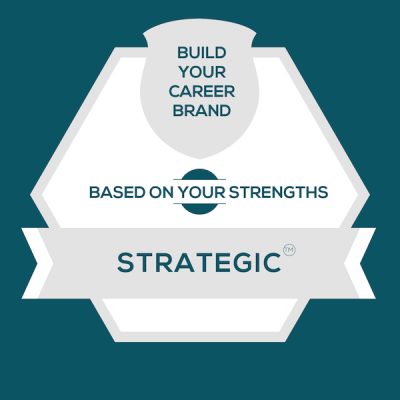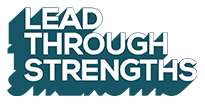Strategic Strength – Build A Genuine Career Brand
Podcast: Play in new window
Subscribe: Spotify | iHeartRadio | Email | TuneIn | More
 Strategic Strength: Get Known For Your Talent
Strategic Strength: Get Known For Your Talent
I get a steady stream of questions about how to align your CliftonStrengths talent theme of Strategic to your career. In this series, I break down one strength per episode — so that you can add to the insights from your StrengthsFinder report and make a better match between your job and your strengths.
- If you’re exploring as a manager, use this series for career development ideas and even new clues about responsibilities you could give a person with this talent theme so that they can show up at their best.
- If you’re exploring for yourself, use this as a chance to build a reputation for your strengths so that you’re more likely to be given assignments that live in your strengths zone.
Career Branding For The Strategic Strength
Today, the talent theme of the episode is Strategic strength. You’ll get three layers to chew on:
- Career Branding
- Red Flag Situations At Work
- Fresh Application Ideas
You probably already have a reputation for what you know. If you imagine your resume or your LinkedIn profile, I bet it's full of “the what,” which are things like job titles, skills, knowledge, expertise, or the degree you earned. Now, what’s missing in most of them is "the how,” and this is where your StrengthsFinder talent themes live. This is an overlooked use for tools like LinkedIn, which is not just for job seekers.
I bet you are just like my StrengthsFinder training clients, where you don’t see your teammates and customers every day. That’s why LinkedIn has become so important for career branding - it’s how your teammates, customers, and vendors go look you up before a meeting - to see who they’re about to talk to. And rather than only telling them what you know, you should also give them a peek at how it is to work with you.
Here are a bunch of adjectives to consider using in your career branding efforts and your LinkedIn profile when you lead through the Strategic strength:
- Thinker
- Prioritizer
- Mapmaker
- Sorter
- Decisive
- Planner
- Evaluator
- Strategist
- Anticipator
- Creative
- Pattern-Spotter
- Future-Oriented
- Fast Decision Maker
- Culler Of Lists
- Vetter Of Ideas
- Simplifier
- Creative Strategist
Red Flag Situations When You Lead With The Strategic Strength
These are the cultures, interactions, or situations that might feel like soul-sucking drudgery to someone with the talent theme of Strategic. They might even make you want to quit the team. So I’ll give you a couple of these to be on the watch for — because if they fester, you might get the urge to quit the job or become detached at work.
Here are a couple of Red flags for the Strategic strength (talent theme):
- A culture of slow decision making or analysis paralysis. If you lead through the Strategic strength and you're stuck in status quo while you can already see the clear path ahead, you will likely spend your days at work in extreme frustration.
- Micromanaging your decision process after trust and credibility are built. If you lead through the Strategic strength and you’ve already built credibility, yet you’re still being questioned deeply and constantly about your decisions, it will impact you beyond the lack of trust. It will hit you at the core because you like moving into the future. If you have to justify every detail, you’ll likely be counting the wasted minutes you could have been using toward progress, which is a serious drain on your psyche. Instead, you're probably at your best when you can sort quickly and take action.
3 Fresh Application Ideas For The Strategic Strength
These are ways to apply the talent theme of Strategic at work , even when the job duties on the team feel pretty locked in. If you’re reading this as a team manager, be sure to have a conversation around these ideas. You’ll both be able to come up with places to apply them.
For someone who leads through the Strategic strength, put the talent to good use with one of these options:
- Put this talent to use when you need a workaround. Sometimes, the long-term solution to a problem is in in the works...and meanwhile you need a bandaid-type solution to also cope in the short-term. Usually, someone with the Strategic talent will be able to sort all of the options quickly and get into the workaround-action on the same day.
- When there’s a topic on the team that seems confusing and overly complex to everyone. Get a whiteboard in front of the person with the Strategic talent and see if they can simplify the complex in a way that helps everyone nod their heads in agreement that they’re looking at the same thing. This could be drawing a contextual model or framework. This could be dissecting a problem. Or even getting everyone to agree on what the problem is that you’re solving.
- Use this person for collaboration insight. When you’re hearing that stakeholders are not getting consulted or that people are frustrated that your process changes have a negative impact on their work, get someone with Strategic talent involved. They’re great at seeing the handoffs between steps in the process. And they can predict what consequences will come from small upstream changes by the time they get to the 3rd or 4th person down the way.
So there you have it. It’s a quick tour for building your career through the talent theme of Strategic.
Here's Your Personal Branding Homework For The Strategic Strength
- Go take action on your LinkedIn profile with the career branding section. Challenge yourself to write one sentence in the Summary section of LinkedIn that captures how you collaborate as a teammate at work.
- Then think over the red flags to see if there’s anything you need to get in front of before it brings you down.
- Volunteer your talents through the application ideas. And if you’re a manager, have a conversation with your team members about which of these things sound like something they’d love to have more of.
- Dig into the Strategic strength all the way. You can really nerd out on the nuances on the Strategic Talent Theme Page.
Here's A Full Transcript Of The 8 Minute Episode
You're listening to Lead Through Strengths, where we hope work teams apply their greatest strengths at work. I'm your host, Lisa Cummings and I gotta tell you, it's hard to find something more energizing than using your natural talents every day at work. And as you might expect, I get tons of questions about how to align your CliftonStrengths talent themes, with your career choices.
So, in this series, I break down one strength per episode. This time, it’s Strategic, so that you can add to the insights from your StrengthsFinder reports, and make a better match between your job and your strengths.
If you're listening, as a manager, use this series for career development ideas for your team, and even to get new clues about responsibilities or tasks that you could give a person with this talent theme, so that they can show up at their best when they show up at work.
If you're listening for yourself, because you have the Strategic talent, use this as a chance to build a reputation for your strengths, so that you're more likely to be given assignments that let you live in your strengths zone.
So today, as you've heard, the talent theme of the episode is Strategic. You'll get three layers to chew on. One is career branding. The second is red flag situations at work. And three is your fresh application ideas.
So, we kick-off with career branding for Strategic. You know, you probably already have a reputation for what you know. If you imagine your resume or LinkedIn profile, it's probably full of the what which are things like the job titles, the skills, the knowledge, the experience, the expertise, or even the degree that you earned.
But now, what I see that is missing from most of them is the how. And this is where your StrengthsFinder talent themes live, they live in the how. And this is an overlooked use for tools like LinkedIn and that's not just a tool for job seekers. I bet in fact, you're just like my StrengthsFinder training clients, where you don't see your teammates and customers every day. That's why LinkedIn has become so important for career branding, because it's how your teammates and your customers and your vendors go look you up before a meeting. They want to see who they're about to talk to. And rather than only telling them what it is that you know, you should also be giving them a peek at how it is to work with you.
So here are a bunch of adjectives that you could consider using and weaving into your career branding efforts in your LinkedIn profile. So, people who lead through Strategic are often fast decision makers. They’re colors of lists. They’re pattern spotters. They are vetters of ideas. They're simplifiers. They're planners. They're creative strategists. And they're anticipators who see the downstream effect of work.
You get the idea. It's a lot more exciting than saying, “I'm a motivated team player.” Okay, so that's career branding.
Now let's move to red flag situations at work. These are team cultures or interactions or situations that will feel like soul-sucking drudgery to you. If you have the talent theme of Strategic and they might even make you want to quit. So, I'll give you a couple of these to be on watch for because if they fester, you might get the urge to quit your job or become detached or disengaged at work all bad.
So here are two important red flags for Strategic.
One, analysis paralysis. If you're in a culture that is slow to make decisions, or they get stuck in analysis paralysis, well, that could be a problem if you have Strategic and you're stuck in the status quo. And you can already see the clear path ahead, you're going to spend your days at work in extreme frustration.
Okay, the second one is another red flag. This is being questioned. If you have Strategic and you've already built credibility, yet you're still being questioned deeply and constantly about your decisions, it will impact you beyond a feeling of lack of trust. It's going to hit you at the core, because you like movement into the future. And if you have to justify every detail, you're going to be counting the wasted minutes you could have been using toward progress and so that's going to be a serious drain on your psyche.
Okay, now moving into application ideas for Strategic. These are ways you can apply the talent themes at work, even when your job duties on the team feel like they're pretty locked in as they are. If you're listening as a manager, that's how I'm going to phrase these as if you're the manager assigning responsibilities around these. So be sure to have conversations with your team member. And if you're listening and you have this talent theme, be thinking about how you could volunteer these talents.
For someone who leads through Strategic, put this talent to use with one of those team members, with one of these three options.
One, work-arounds. Sounds kind of weird but sometimes you just need a band-aid. Sometimes you need a workaround in the short-term. Sometimes the long-term solution to a problem is in the works but meanwhile, you do need a band-aid type solution to be able to cope in the short term.
And somebody with the Strategic talent will be able to sort out all of the options, even when there are a bunch of bad options. They can look at them quickly and get you into action in the same day, so you can pick the best thing for the situation.
The second, let's talk about complexity. When there's a topic on the team that seems confusing and overly complex to everyone, and you're going in circles about having those deja vu meetings where you're saying the same thing about the same thing about the same thing but you're going nowhere, get a whiteboard in front of the person with the Strategic talent and see if they can simplify the complex in a way that helps everyone nod their head in agreement or alignment. “Oh, yeah, we're looking at the same thing.”
Now, this could be that person drawing a contextual model or framework. It could be that they're dissecting the problem and getting to a root cause, or even just a process map on the whiteboard to get people to agree on what the problem is that you're solving. The bottom line is, if you have Strategic, you're great at simplifying the complex. And so, as a manager, you can put people on that job in the small moments when the team is getting stuck.
A third option for application, this is collaboration insight. So, when you're hearing a little chatter in the office, that stakeholders aren't getting consulted on things that they want to know about, or that people are frustrated, because you're imposing process changes, and they have a negative impact on their work, and they didn't hear about it until all of a sudden, their workload exploded because of you guys on your team, get someone with the Strategic talent involved.
They're great at seeing the handoffs between steps in the process, and they can predict consequences that come from small upstream changes. And you know, by the time they get to the third or fourth person down the way, maybe those consequences have blown up, and other people don't see what it's going to create, but someone with Strategic likely can.
So, there you have it. It's a quick tour for building your career through the talent theme of Strategic. So, here's the homework.
One, if you have this talent theme, go take action on your LinkedIn profile and the summary. Think about a career branding section and challenge yourself to write one sentence in the summary that captures how you collaborate as a teammate at work.
The second one is, think over those red flags, and see if there's anything that you need to get in front of before it brings you down. Or if you're managing someone with this talent theme, if this is part of your work culture, and you have people who lead through Strategic, be on watch for this. And whether it is bringing them down, you need to watch it, manage it, reframe it.
And finally, the third one, volunteer the talents through the application ideas. If you're a manager, have a conversation with a team member about which of these things sound like something they'd love to have more of.
So, with that, I'm your host, Lisa Cummings from Lead Through Strengths. If you're thinking about doing a virtual or in person, StrengthsFinder training event, to kick-off your strengths-based culture, head on over to leadthroughstrengths.com/training to check it out and see if our current offerings are a good fit for you.
So, until next time. Thank you for being part of this powerful strengths movement that helps people unleash the awesomeness that they already have inside them.

